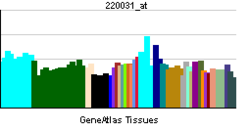- OTUD7B
-
OTU domain containing 7B Identifiers Symbols OTUD7B; CEZANNE; ZA20D1 External IDs OMIM: 611748 MGI: 2654703 HomoloGene: 10624 GeneCards: OTUD7B Gene EC number 3.4.19.12 Gene Ontology Molecular function • DNA binding
• ubiquitin thiolesterase activity
• protein binding
• peptidase activity
• cysteine-type peptidase activity
• zinc ion binding
• metal ion bindingCellular component • nucleus
• cytoplasm
• microtubule cytoskeletonBiological process • protein deubiquitination
• negative regulation of I-kappaB kinase/NF-kappaB cascadeSources: Amigo / QuickGO RNA expression pattern 
More reference expression data Orthologs Species Human Mouse Entrez 56957 229603 Ensembl ENSG00000163113 ENSMUSG00000038495 UniProt Q6GQQ9 n/a RefSeq (mRNA) NM_020205 NM_001025613 RefSeq (protein) NP_064590 NP_001020784 Location (UCSC) Chr 1:
149.91 – 149.98 MbChr 3:
95.91 – 95.97 MbPubMed search [1] [2] OTU domain-containing protein 7B is a protein that in humans is encoded by the OTUD7B gene.[1][2]
References
- ^ Evans PC, Taylor ER, Coadwell J, Heyninck K, Beyaert R, Kilshaw PJ (Jul 2001). "Isolation and characterization of two novel A20-like proteins". Biochem J 357 (Pt 3): 617–23. doi:10.1042/0264-6021:3570617. PMC 1221992. PMID 11463333. http://www.pubmedcentral.nih.gov/articlerender.fcgi?tool=pmcentrez&artid=1221992.
- ^ "Entrez Gene: OTUD7B OTU domain containing 7B". http://www.ncbi.nlm.nih.gov/sites/entrez?Db=gene&Cmd=ShowDetailView&TermToSearch=56957.
Further reading
- Gerhard DS, Wagner L, Feingold EA, et al. (2004). "The status, quality, and expansion of the NIH full-length cDNA project: the Mammalian Gene Collection (MGC).". Genome Res. 14 (10B): 2121–7. doi:10.1101/gr.2596504. PMC 528928. PMID 15489334. http://www.pubmedcentral.nih.gov/articlerender.fcgi?tool=pmcentrez&artid=528928.
- Suzuki Y, Yamashita R, Shirota M, et al. (2004). "Sequence comparison of human and mouse genes reveals a homologous block structure in the promoter regions.". Genome Res. 14 (9): 1711–8. doi:10.1101/gr.2435604. PMC 515316. PMID 15342556. http://www.pubmedcentral.nih.gov/articlerender.fcgi?tool=pmcentrez&artid=515316.
- Beausoleil SA, Jedrychowski M, Schwartz D, et al. (2004). "Large-scale characterization of HeLa cell nuclear phosphoproteins.". Proc. Natl. Acad. Sci. U.S.A. 101 (33): 12130–5. doi:10.1073/pnas.0404720101. PMC 514446. PMID 15302935. http://www.pubmedcentral.nih.gov/articlerender.fcgi?tool=pmcentrez&artid=514446.
- Evans PC, Ovaa H, Hamon M, et al. (2004). "Zinc-finger protein A20, a regulator of inflammation and cell survival, has de-ubiquitinating activity.". Biochem. J. 378 (Pt 3): 727–34. doi:10.1042/BJ20031377. PMC 1224040. PMID 14748687. http://www.pubmedcentral.nih.gov/articlerender.fcgi?tool=pmcentrez&artid=1224040.
- Evans PC, Smith TS, Lai MJ, et al. (2003). "A novel type of deubiquitinating enzyme.". J. Biol. Chem. 278 (25): 23180–6. doi:10.1074/jbc.M301863200. PMID 12682062.
- Strausberg RL, Feingold EA, Grouse LH, et al. (2003). "Generation and initial analysis of more than 15,000 full-length human and mouse cDNA sequences.". Proc. Natl. Acad. Sci. U.S.A. 99 (26): 16899–903. doi:10.1073/pnas.242603899. PMC 139241. PMID 12477932. http://www.pubmedcentral.nih.gov/articlerender.fcgi?tool=pmcentrez&artid=139241.
- Heyninck K, Beyaert R (1999). "The cytokine-inducible zinc finger protein A20 inhibits IL-1-induced NF-kappaB activation at the level of TRAF6.". FEBS Lett. 442 (2-3): 147–50. doi:10.1016/S0014-5793(98)01645-7. PMID 9928991.
Categories:- Human proteins
- Chromosome 1 gene stubs
Wikimedia Foundation. 2010.
